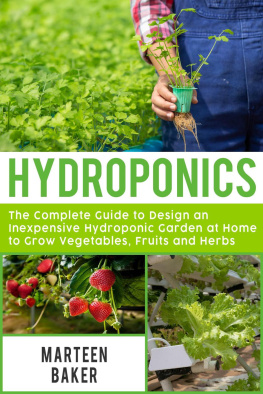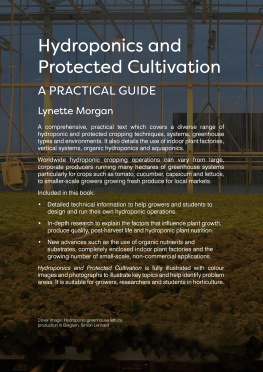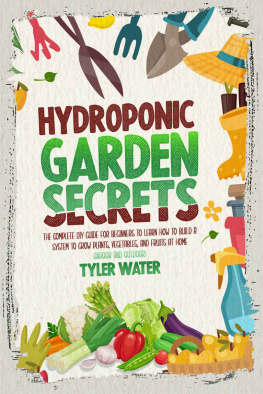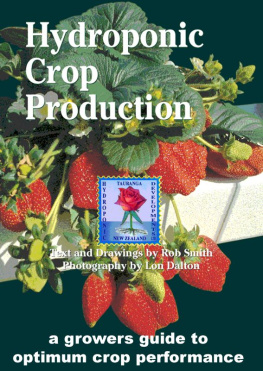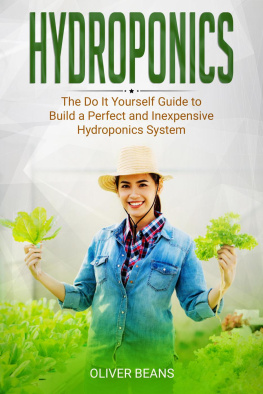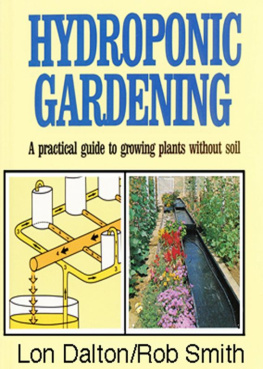DIY Hydroponic Gardens
How to Design And Build A Hydroponic System
Brian Hackett
Copyright 2020 Brian Hackett
All rights reserved.
ISBN: 9798664083194
DEDICATION
The author and publisher have provided this e-book to you for your personal use only. You may not make this e-book publicly available in any way. Copyright infringement is against the law. If you believe the copy of this e-book you are reading infringes on the author's copyright, please notify the publisher at: https://us.macmillan.com/piracy
Contents
I. Introduction
II. Hydroponic growing system
III. Equipment
IV. A Simple Guide to Starting Seeds for Hydroponics
VII. System Maintenance
VIII. Common problems and troubleshooting
I. Introduction
What is hydroponics ?
The word, Hydroponic, comes from Latin and means working water. Simply put, it is the art of growing plants without soil.
When most people think of hydroponics, they think of plants grown with their roots suspended directly into water with no growing medium. This is just one type of hydroponic gardening known as N.F.T. (nutrient film technique). There are several variations of N.F.T. used around the world and it is a very popular method of growing hydroponically. What most people dont realize is that there are countless methods and variations of hydroponic gardening. In this section, we explain the most common, including the pros and cons of each along with an abundance of great, general information about hydroponics.
Advantages of hydroponic growing
1. No soils needed
In a sense, you can grow crops in places where the land is limited, doesn't exist, or is heavily contaminated. In the 1940s, Hydroponics was successfully used to supply fresh vegetables for troops in Wake Island, a refueling stop for Pan American airlines. This is a distant arable area in the Pacific Ocean. Also, Hydroponics has been considered as the farming of the future to grow foods for astronauts in the space (where there is no soil) by NASA.
2. Make better use of space and location
Because all that plants need are provided and maintained in a system, you can grow in your small apartment, or the spare bedrooms as long as you have some spaces.
Plants' roots usually expand and spread out in search of foods, and oxygen in the soil. This is not the case in Hydroponics, where the roots are sunk in a tank full of oxygenated nutrient solution and directly contact with vital minerals. This means you can grow your plants much closer, and consequently huge space savings.
3. Climate control
Like in greenhouses, hydroponic growers can have total control over the climate - temperature, humidity, light intensification, the composition of the air. In this sense, you can grow foods all year round regardless of the season. Farmers can produce foods at the appropriate time to maximize their business profits.
4. Hydroponics is water-saving
Plants grown hydroponically can use only 10% of water compared to field-grown ones. In this method, water is recirculated. Plants will take up the necessary water, while run-off ones will be captured and return to the system. Water loss only occurs in two forms - evaporation and leaks from the system (but an efficient hydroponic setup will minimize or don't have any leaks).
It is estimated that agriculture uses up to 80% water of the ground and surface water in the US.
While water will become a critical issue in the future when food production is predicted to increase by 70% according to the FAQ, Hydroponics is considered a viable solution to large-scale food production.
5. Effective use of nutrients
In Hydroponics, you have a 100% control of the nutrients (foods) that plants need. Before planting, growers can check what plants require and the specific amounts of nutrients needed at particular stages and mix them with water accordingly. Nutrients are conserved in the tank, so there are no losses or changes of nutrients like they are in the soil.
6. pH control of the solution
All of the minerals are contained in the water. That means you can measure and adjust the pH levels of your water mixture much more easily compared to the soils. That ensures the optimal nutrients uptake for plants.
7. Better growth rate
Is hydroponically plants grown faster than in soil? Yes, it is.
You are your own boss that commands the whole environment for your plants' growth - temperature, lights, moisture, and especially nutrients. Plants are placed in ideal conditions, while nutrients are provided at the sufficient amounts, and come into direct contacts with the root systems. Thereby, plants no longer waste valuable energy searching for diluted nutrients in the soil. Instead, they shift all of their focus on growing and producing fruits.
8. No weeds
If you have grown in the soil, you will understand how irritating weeds cause to your garden. It's one of the most time-consuming tasks for gardeners - till, plow, hoe, and so on. Weeds are mostly associated with the soil. So eliminate soils, and all bothers of weeds are gone.
9. Fewer pests & diseases
And like weeds, getting rids of soils helps make your plants less vulnerable to soil-borne pests like birds, gophers, groundhogs; and diseases like Fusarium, Pythium, and Rhizoctonia species.Also when growing indoors in a closed system, the gardeners can easily take controls of most surrounding variables.
10. Less use of insecticide, and herbicides
Since you are using no soils and while the weeds, pests, and plant diseases are heavily reduced, there are fewer chemicals used. This helps you grow cleaner and healthier foods. The cut of insecticide and herbicides is a strong point of Hydroponics when the criteria for modern life and food safety are more and more placed on top.
11. Labor and time savers
Besides spending fewer works on tilling, watering, cultivating, and fumigating weeds and pests, you enjoy much time saved because plants' growth is proven to be higher in Hydroponics. When agriculture is planned to be more technology-based, Hydroponics has a room in it.
12. Hydroponics is a stress-relieving hobby
This interest will put you back in touch with nature. Tired after a long working day and commute, you return to your small apartment corner, it's time to lay back everything and play with your hydroponic garden. Reasons like lack of spaces are no longer right. You can start fresh, tasty vegetables, or vital herbs in your small closets, and enjoy the relaxing time with your little green spaces.
Seem like there are lots of benefits of Hydroponics and the image below seems to try to persuade you into Hydroponic growing. But keep reading to learn about its downsides.
II. Hydroponic growing system
Regardless of whether you are an experienced horticulturist seeking to upgrade your old hydroponic grow system, or perhaps you are a novice to the indoor gardening world, do not have any worries, you will find the ideal hydroponic system to help you have that ideal indoor garden.
There are some things that you will need to consider when designing or even buying your Hydroponics systems.
For example, if you will need to use it frequently, you may need to consider things like how hard it can be to clean between plantings.
Additionally, if you have a challenge while the plants are growing, you may think of how hard it can be to fix the issues without damaging the plants.




